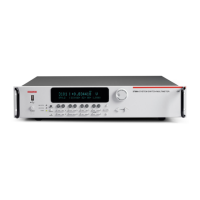DC voltage, DC current, and resistance measurement accuracy
To optimize measurement accuracy:
• 1 or 5 NPLC, filter off, fixed range.
• Use relative offset on DC voltage and 2-wire resistance measurements when appropriate.
• Use four-wire, offset compensation on, and line sync on for resistance measurements, especially
through a Series 3700A switch card, for best accuracy.
AC voltage and AC current optimize accuracy
Select Detectorbandwidth 3, autodelays On, and fixed range.
Temperature optimize accuracy
1 or 5 NPLC.
Voltage
DC volts input divider
Normally, the input resistance for the 100 mVDC, 1 VDC, and 10 VDC ranges is more than 10 GΩ.
You can set the input resistance for the three lower DC volt ranges to 10 MΩ by enabling the input
divider.
When you enable the input divider:
• The measurement INPUT HI is connected to INPUT LO
• Some external devices (such as a high voltage probe) must be terminated to a 10 MΩ load
• The measurement of open leads is maintained near 0 V
• Internal I
BIAS
through the 10 MΩ causes an open input to read less than – 0.4 mV. With a short
circuit (and the input divider on or off), the short circuit to read less than ±0.9 µV.
The input divider can be enabled from the front panel when function is "dcvolts" by pressing the
CONFIG key, then the DMM key.
To control the divider over the remote interface, use the dmm.inputdivider (on page 11-182)
command.
Low level considerations
For sensitive measurements, external considerations affect the accuracy. Effects that are not
noticeable when working with higher voltages are significant in microvolt signals. The Series 3700A
reads only the signal received at its input; therefore, it is important that this signal be properly
transmitted from the source. The following paragraphs indicate factors that affect accuracy, including
stray signal pick-up and thermal offsets.
Shielding
AC voltages that are extremely large compared with the DC signal to be measured may produce an
erroneous output. Therefore, to minimize AC interference, the circuit should be shielded, with the
shield connected to the Series 3700A input low (particularly for low-level sources). Improper shielding
can cause the Series 3700A to behave in one or more of the following ways:
• Unexpected offset voltages
• Inconsistent readings between ranges
• Sudden shifts in reading

